The GeForce GTX 660 Ti Review, Feat. EVGA, Zotac, and Gigabyte
by Ryan Smith on August 16, 2012 9:00 AM ESTPower, Temperature, & Noise
As always, we’re wrapping up our look at a video card’s stock performance with a look at power, temperature, and noise. Like we discussed in the introduction, while the official TDP of the GTX 660 Ti is 150W – 20W lower than the GTX 670 – the power target difference is only 7W. So let’s see which is more accurate, and how that compares to AMD’s cards.
| GeForce GTX 660 Ti Voltages | ||||
| Zotac GTX 660 Ti Boost Load | EVGA GTX 660 Ti Boost Load | Gigabyte GTX 660 Ti Boost Load | ||
| 1.175v | 1.162v | 1.175v | ||
Stopping to take a quick look at voltages, there aren’t any big surprises here. NVIDIA would need to maintain the same voltages as the GTX 670 because of the identical clocks and SMX count, and that’s exactly what has happened. In fact all single-GPU GK104 cards are topping out at 1.175v, NVIDIA’s defined limit for these cards. Even custom cards like the Gigabyte still only get to push 1.175v.
Up next, before we jump into our graphs let’s take a look at the average core clockspeed during our benchmarks. Because of GPU boost the boost clock alone doesn’t give us the whole picture – particularly when also taking a look at factory overclocked cards – we’ve recorded the clockspeed of our video cards during each of our benchmarks when running them at 2560x1600 and computed the average clockspeed over the duration of the benchmark. Unfortunately we then deleted the results for the factory overclocked cards, so we only have the “reference” card. Sorry about that guys.
| GeForce GTX 600 Series Average Clockspeeds | |||||||
| GTX 670 | GTX 660 Ti | Zotac GTX 660 Ti | EVGA GTX 660 Ti | Gigabyte GTX 660 Ti | |||
| Max Boost Clock | 1084MHz | 1058MHz | 1175MHz | 1150MHz | 1228MHz | ||
| Crysis | 1057MHz | 1058MHz | N/A | ||||
| Metro | 1042MHz | 1048MHz | |||||
| DiRT 3 | 1037MHz | 1058MHz | |||||
| Shogun 2 | 1064MHz | 1035MHz | |||||
| Batman | 1042MHz | 1051MHz | |||||
| Portal 2 | 988MHz | 1041MHz | |||||
| Battlefield 3 | 1055MHz | 1054MHz | |||||
| Skyrim | 1084MHz | 1045MHz | |||||
| Civilization V | 1038MHz | 1045MHz | |||||
The average clockspeeds on our “reference” GTX 660 Ti don’t end up fluctuating all that much. With a max boost of 1058 the card actually gets to run at its top bin in a few of our tests, and it isn’t too far off in the rest. The lowest is 1035 for Shogun 2, and that’s only an average difference of 22MHz. The GTX 670 on the other hand had a wider range; a boon in some games and a bane in others. If nothing else, it means that despite the identical base and boost clocks, our cards aren’t purely identical at all times thanks to the impact of GPU boost pulling back whenever we reach our power target.
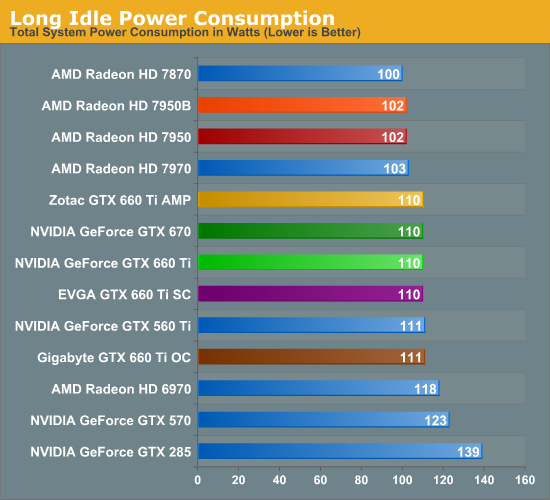
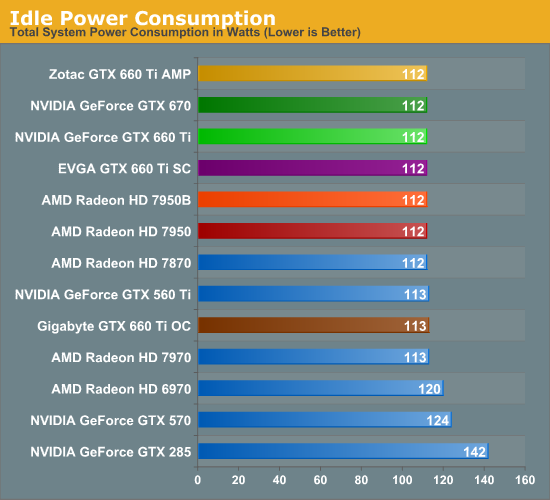
There are no great surprises with idle power consumption. Given the immense similarity between the GTX 670 and GTX 660 Ti, they end up drawing the same amount of power both during idle and long idle. This does leave AMD with an 8W-10W lead at the wall in this test though.
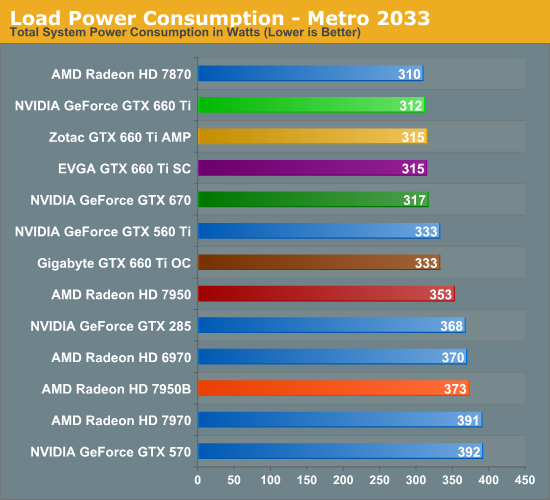
Moving on to our load power tests we start with Metro: 2033. As we mentioned previously the GTX 660 Ti and GTX 670 have very similar power targets, and this benchmark confirms that. Power consumption for the GTX 660 Ti is virtually identical to the Radeon HD 7870, an interesting matchup given the fact that this is the first time NVIDIA has had to compete with Pitcairn. Pitcairn’s weaker compute performance means it starts off in a better position, but it looks like even with a salvaged GK104 NVIDIA can still compete with it. NVIDIA drove efficiency hard this generation; to compete with a smaller chip like that is certainly a testament to that efficiency.
As for the inevitable 7950 comparison, it’s no contest. The GTX 670 was already doing well here and the GTX 660 Ti doesn’t change that. Tahiti just can’t match GK104’s gaming efficiency, which is why AMD has had to push performance over power with the new 7950B.
Meanwhile it’s fascinating to see that the GTX 660 Ti has lower power consumption than the GTX 560 Ti, even though the latter has the advantage of lower CPU power consumption due to its much lower performance in Metro. Or better yet, just compare the GTX 660 Ti to the outgoing GTX 570.
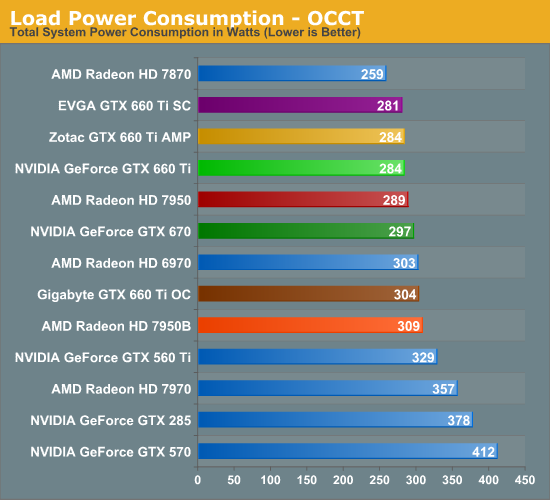
For AMD/NVIDIA comparisons we have a bit less faith in our OCCT results than we do our Metro results right now, as NVIDIA and AMD seem to clamp their power consumption differently. NVIDIA’s power consumption clamp through GPU Boost is far softer than AMD’s PowerTune. As a result the 7870 consumes 25W less than the GTX 660 Ti here, which even with AMD’s very conservative PowerTune rating seems like quite the gap. Metro seems to be much more applicable here, at least when you’re dealing with cards that have similar framerates.
In any case, compared to NVIDIA’s lineup this is another good showing for the GTX 660 Ti. Power consumption at the wall is 45W below the GTX 560 Ti, a large difference thanks to the latter’s lack of power throttling technology.
As for our factory overclocked cards, these results are consistent with our expectations. Among the Zotac and EVGA cards there’s a few watts of flutter at best, seeing as how they have the same power target of 134W. Meanwhile the Sapphire card with its higher power target is 20W greater at the wall, which indicates that our estimated power target of 141W for that card is a bit too low. However this also means that those times where the Gigabyte card was winning, it was also drawing around 20W more than its competition, which is a tradeoff in and of itself.
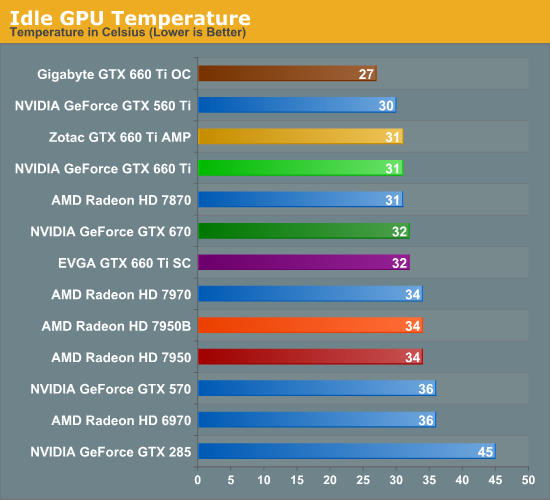
Moving on to temperatures, at 31C the GTX 660 Ti is once more where we’d expect it to be given the similarities to the GTX 670. Open air coolers tend to do a bit better here than blowers though, so the fact that it’s only 1C cooler than the blower-type GTX 670 is likely a reflection on Zotac’s cooler.
Speaking of factory overclocked video cards, one card stands out above the rest: the Gigabyte GTX 660 Ti. That oversized cooler does its job and does it well, keeping the GPU down to barely above room temperature.
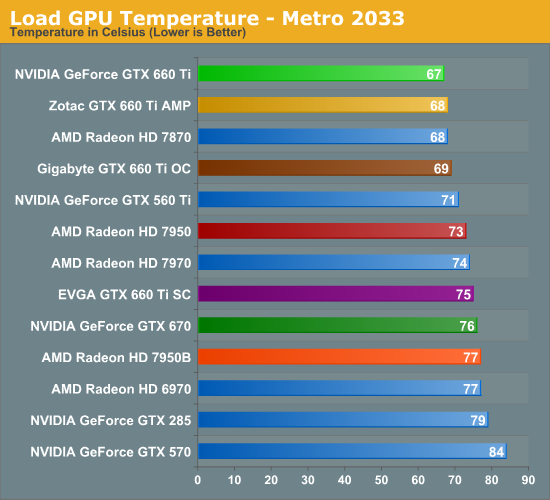
Considering that most of our high-end cards are blowers while our “reference” GTX 660 Ti is an open air cooler, temperature benchmarks are the GTX 660 Ti’s to win, and that’s precisely what’s going on. 67C is nice and cool too, which means that the open air coolers should fare well even in poorly ventilated cases.
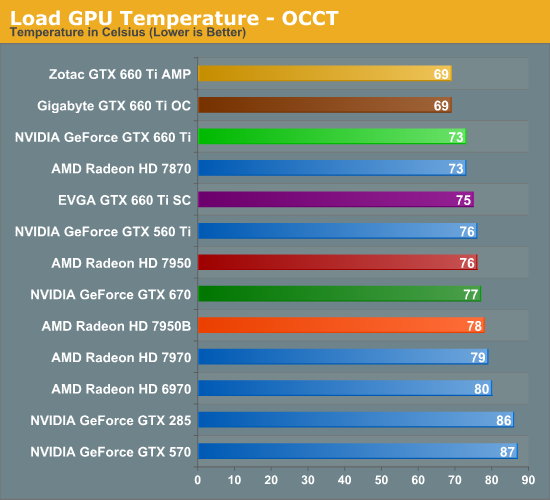
As usual we see a rise in temperatures when switching from Metro to OCCT, but at 73C the GTX 660 Ti is still the coolest reference (or semi-reference) card on the board. To be honest we had expected that it would beat the 7870, but as far as blowers go the 7870’s is quite good.
Moving on to our factory overclocked cards, we’re seeing the usual divisions between open air coolers and blowers. The blower-based EVGA card performs almost identically to the GTX 670, which makes sense given the similarities between the cards. Meanwhile the open air Zotac and Gigabyte cards are neck-and-neck here, indicating that both cards are shooting for roughly the same temperatures, keeping themselves below 70C. Though it’s somewhat weird to see the factory overclocked Zotac card end up being cooler than its reference-clocked self; this appears to be a product of where the fan curve is being hit.
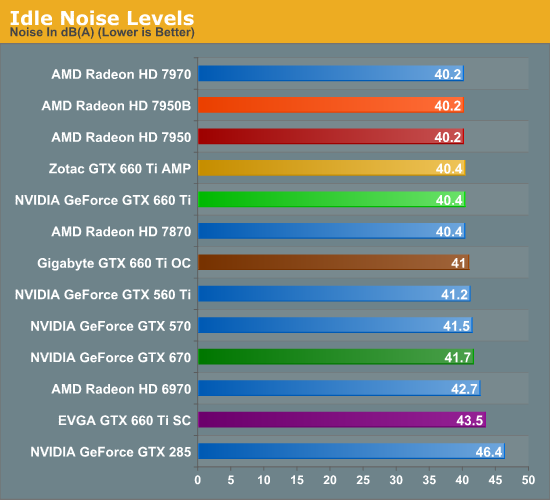
Last but not least we have our look at noise, where we’ll hopefully be able to fully shake out our factory overclocked cards.
Right off the bat we see the blower-based EVGA struggle, which was unexpected. It’s basically the same cooler as the GTX 670, so it should do better. Then again the EVGA GTX 670 SC had the same exact problem.
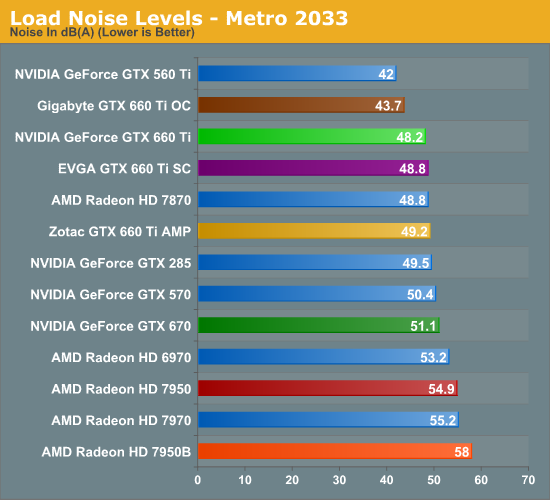
As for Metro, the GTX 660 Ti once again looks good. 48.2 isn’t the best for an open air cooler, but it’s a hair quieter than the 7870 and notably quieter than the GTX 670. The only unfortunate part about these results is that it just can’t beat the GTX 560 Ti; in fact nothing can. For its power consumption the GTX 560 Ti was an almost unreal card, but it’s still a shame the GTX 660 Ti can’t be equally unreal.
Moving on to our factory overclocked cards however, the Gigabyte GTX 660 Ti OC gets very close thanks to its very large cooler. 43.7dB technically isn’t silent, but it just as well should be. To offer the performance of a GTX 660 Ti (and then some) in such a package is quite the accomplishment.
As for Zotac and EVGA, there’s nothing bad about either of them but there’s also nothing great. EVGA’s card is about average for a blower, while Zotac’s card seems to be suffering from its size. It’s a relatively tiny card with a relatively tiny cooler, and this has it working harder to hit its temperature targets.
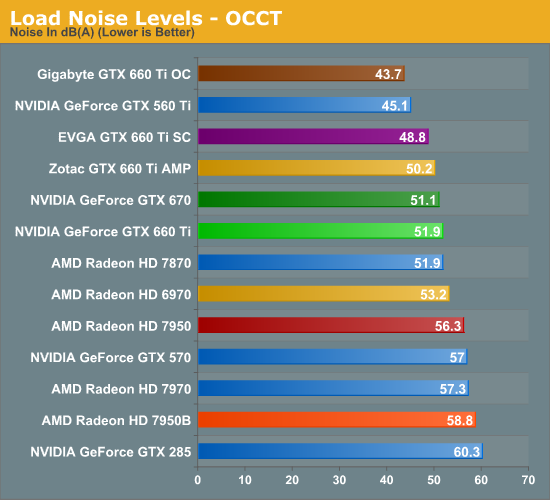
Finally we have noise testing with OCCT. Our “reference” GTX 660 Ti actually fares a bit worse than the GTX 670, which is unfortunate. So much of this test comes down to the cooler though that it’s almost impossible to predict how other cards will perform. At least it’s no worse than the 7870.
Meanwhile the Gigabyte GTX 660 Ti OC continues to impress. 43.7dB not only means that it didn’t get any louder switching from Metro to OCCT, but it has now bested the GTX 560 Ti thanks to the 560’s lack of power throttling technology. Make no mistake, 43.7dB for this kind of performance is very, very impressive.
As for EVGA and Zotac, it’s also a rehash of Metro. EVGA’s blower is actually over 1dB quieter than Zotac’s cooler, which is an unfortunate outcome for an open air cooler.
Wrapping things up, even without a true reference sample from NVIDIA it’s clear that the GTX 660 Ti has a lot of potential when it comes to power/temp/noise. Compared to other cards it’s roughly equivalent in power consumption and noise to the 7870, which for NVIDIA is an important distinction since it’s also notably faster than the 7870, so NVIDIA is on a better place on the power/performance curve. This goes for not only the 7870, but especially the 7950, where the GTX 660 Ti continues the tradition the GTX 670 already set, which will see the GTX 660 Ti being cooler, quieter, and less power hungry than AMD’s entry-level Tahiti part.
But it must be pointed out that the lack of a reference design for the GTX 660 Ti means buyers are also facing a lot of variability. Power consumption should be consistent between cards – which is to say a hair less than the GTX 670 – but temperature and especially noise will vary on a card by card basis. Potential buyers would best be served by checking out reviews ahead of time to separate the duds from the gems.










313 Comments
View All Comments
Nfarce - Thursday, August 16, 2012 - link
The GTX 680 is 20% higher in performance than the 660Ti but it comes at a lofty 67% higher price tag. The 670 is just 10% faster but still comes at a 33% price premium. I was upset after dropping 5 Benjamins on an EVGA 680 Superclocked when the 670 came out. I should have waited on THAT card and saved a hundred. Now this card is out and two of these in SLI will slaughter my 680 by a 35% margin for just another 20% in cost (according to Guru3D's SLI tests). Just damn on my timing and decisions. Methinks I'm selling the 680 for a $50 loss and get two of these for $600. Sure beats the original plan of spending $1,000 in a 680 SLI setup.CeriseCogburn - Sunday, August 19, 2012 - link
This place and Tom's very conveniently left out the 680 in all the charts but made biased assured that the 7970 was in every single one of them.TheJian - Monday, August 20, 2012 - link
Another 680 at newegg is $499 (lots of choices). Two 680's will smoke the two 660's for $100 less. Since you already own one ;) If you buy two of either, I hope you're going to run them at 5760x1200 (3 monitors or 3840x1200? two monitors?). Wasted power otherwise. 1920x1200 is already 100fps+ in almost everything on a GTX 680.But sorry about you jumping early :) That's the price any of us pay for being first on the block to have the latest toys :) Also note, you can turn down both 680's and have a silent seriously butt kicking machine until you actually need the power. No heat or noise until you actually need it. Let's face it, two 680's is a LOT of freaking performance.
Congrats if you've got an extra $500 laying around in these times :) Might want to wait for labor day specials though ;)
xKrNMBoYx - Thursday, August 16, 2012 - link
Is that a typo or is the Zotac GTX 660 Ti AMP! memory clock 600 MHz fasterRyan Smith - Thursday, August 16, 2012 - link
That's not a typo. They are offering a factory memory overclock; the only such vendor to do so according to the list I have.Jaguar36 - Thursday, August 16, 2012 - link
I'd love to see SC2 come back, particularly with the new Arcade games. Some of them can easily bring even a top card to its knees. The final battle of a Desert Strike game will crush even the best cards.TheJian - Tuesday, August 21, 2012 - link
Nah, I'm sure people would whine because it's another victory for Nvidia at 1920x1200 and below (heck I think above also). They could have benched it as before but Ryan probably wanted to leave it out :) He might have had to make a conclusion then, even at 2560x1600... ;)http://www.anandtech.com/show/6025/radeon-hd-7970-...
Note that article is from 6/22/2012. and they used it again here:
http://www.anandtech.com/show/6096/evga-geforce-gt...
7/22/2012...
You see, at 1920x1200 ULTRA + 4xMSAA the GTX670 already scores 121.2 vs. 108.3 for the 7970GE (7970 only gets 99, and the 7950 gets 88.2fps). So you would have the GTX 660 TI smoking the 7970Ghz edition. That wouldn't look too good when it's supposed to be competing against the 7850/7950...LOL. The GTX 670 even beats the 7970GHZ edition in the 2% market share 2560x1600 also. So it may have looked pretty bad against the 660 here also. It would have made his 2560x1600 digs and conclusion even worse and hard to even argue there. Ryan was smart here...Just not quite smart enough if you look at the big picture of evidence.
Understand why they won't bench SC2 again now? Why not run the last version patch that works fine? Did 1.51 not work too (released 8th? a week ago from review date). Instead he keeps in Warhead from 2008 and an engine from 2007 that was only used in 7 games vs. the much more TAXING Crysis 2 (not 1) with DX11 patch and Ultra res patch which turns on a crapload of stuff like:hardware tessellation, soft shadows with variable penumbra, improved water rendering, particle motion blur and shadowing, Parallax Occlusion Mapping, full-resolution High Dynamic Range motion blur, & hardware-based occlusion culling.
"can it run crysis?"...Wrong question, can it run crysis 2! :) I still think it would be close or a loss for NV though with 660. It would be a close call, probably a wash...But that wouldn't help ryan either :) Hence the 2008 game.
CeriseCogburn - Thursday, August 23, 2012 - link
This place for these vidcards is goners man. Good job.Stas - Thursday, August 16, 2012 - link
Disappointed. Was hoping to see it match 7950 to drive the prices down... But it actually loses to 7950. Let alone o/c potential. Ugh... keep waiting.TheJian - Tuesday, August 21, 2012 - link
I'm not even going to waste my time with this BS comment. But see my response to Ryan's lame excuse over 2560x1600 for all the details you SHOULD have seen in his review (and some that he SHOULD have put IN the review). It only one ONE game @1920x1200. In my response to ryan I prove you can't run at 2560x1600 and stay above 30fps.Nice try though. :) Slower my butt.